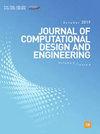海运集装箱码头的泊位分配和调度:解决方法和相关调度属性的最新回顾
IF 6.1
2区 工程技术
Q1 COMPUTER SCIENCE, INTERDISCIPLINARY APPLICATIONS
引用次数: 1
摘要
海运集装箱码头在国际贸易网络和全球市场中发挥着重要作用。为应付快速及稳定增长的海运贸易市场,海运货柜码头营办商必须以适当的分析方法应付营运上的挑战,以配合市场的需要。泊位的分配与调度问题是船舶运营商在作业计划中面临的重要决策之一。泊位调度的优化与空间资源和时间资源的分配密切相关。一个最优稳健的泊位调度可以显著提高港口的生产率和竞争力。在过去几年中,进行了大量的泊位分配和调度研究。因此,有必要进行全面和批判性的文献综述,以分析最新的研究进展、发展趋势、目前的不足和未来可能的研究方向。因此,本研究充分选择了专门研究泊位分配与调度问题的科学论文。所确定的研究根据空间属性进行分类,包括离散、连续和混合泊位分配和调度问题。对确定的研究类别进行了详细的审查。提出了每个类别的代表性数学公式,并详细总结了每个研究的各种考虑因素和特征。特别强调了所采用的解决方法。在综述国内外研究现状的基础上,提出了当前研究的不足和重要的研究需求。本研究旨在协助科学界和相关利益相关者进行泊位分配和调度。本文章由计算机程序翻译,如有差异,请以英文原文为准。
Berth allocation and scheduling at marine container terminals: A state-of-the-art review of solution approaches and relevant scheduling attributes
Marine container terminals play a significant role for international trade networks and global market. To cope with the rapid and steady growth of the seaborne trade market, marine container terminal operators must address the operational challenges with appropriate analytical methods to meet the needs of the market. The berth allocation and scheduling problem is one of the important decisions faced by operators during operations planning. The optimization of a berth schedule is strongly associated with the allocation of spatial and temporal resources. An optimal and robust berth schedule remarkably improves the productivity and competitiveness of a seaport. A significant number of berth allocation and scheduling studies have been conducted over the last years. Thus, there is an existing need for a comprehensive and critical literature survey to analyze the state-of-the-art research progress, developing tendencies, current shortcomings, and potential future research directions. Therefore, this study thoroughly selected scientific manuscripts dedicated to the berth allocation and scheduling problem. The identified studies were categorized based on spatial attributes, including discrete, continuous, and hybrid berth allocation and scheduling problems. A detailed review was performed for the identified study categories. A representative mathematical formulation for each category was presented along with a detailed summary of various considerations and characteristics of every study. A specific emphasis was given to the solution methods adopted. The current research shortcomings and important research needs were outlined based on the review of the state-of-the-art. This study was conducted with the expectation of assisting the scientific community and relevant stakeholders with berth allocation and scheduling.
求助全文
通过发布文献求助,成功后即可免费获取论文全文。
去求助
来源期刊

Journal of Computational Design and Engineering
Computer Science-Human-Computer Interaction
CiteScore
7.70
自引率
20.40%
发文量
125
期刊介绍:
Journal of Computational Design and Engineering is an international journal that aims to provide academia and industry with a venue for rapid publication of research papers reporting innovative computational methods and applications to achieve a major breakthrough, practical improvements, and bold new research directions within a wide range of design and engineering:
• Theory and its progress in computational advancement for design and engineering
• Development of computational framework to support large scale design and engineering
• Interaction issues among human, designed artifacts, and systems
• Knowledge-intensive technologies for intelligent and sustainable systems
• Emerging technology and convergence of technology fields presented with convincing design examples
• Educational issues for academia, practitioners, and future generation
• Proposal on new research directions as well as survey and retrospectives on mature field.
 求助内容:
求助内容: 应助结果提醒方式:
应助结果提醒方式:


